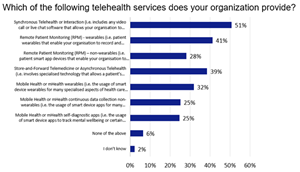Nine out of ten healthcare organizations provide telehealth services, yet almost half face patients’ mistrust towards privacy
Which of the following teleheath services does your organization provide?

Telehealth Graph
Woburn, MA, Nov. 29, 2021 (GLOBE NEWSWIRE) -- New research from Kaspersky reveals that 91% of medical organizations have already implemented telehealth capabilities, with 44% starting to use them after the pandemic. At the same time, 52% of respondents have experienced cases where patients refused telehealth services due to security concerns.
Global events in healthcare in recent years have changed people’s perception of the industry. Medical organizations have adapted to the new conditions, and today, 56% of healthcare institutions are planning to increase their investment in telehealth and virtual care solutions. Kaspersky surveyed healthcare decision-makers to learn how the digital transformation of the industry is going and which problems they believe should be solved to create a world in which everyone can gain access to affordable, fast, and quality care.
According to our research, 71% of global respondents believe telehealth services will add the most value to the healthcare sector within the next five years. Professionals note that remote medicine is practical and attractive in many ways, with advantages such as immediate reach, less disease transmission between patients and staff, and the ability to help more people in a smaller time frame.
This positive approach resonates with real medical practice. Almost half of organizations (42%) agree, most of their patients are more interested in remote than in-person sessions because of their convenience. Other attractive telemedicine features for customers are that modern technologies save time, effort and money and provide the opportunity to consult with a more experienced specialist.
These benefits have led to telehealth services becoming more in demand by patients of all age groups. Contrary to stereotypes that older people are less inclined to trust modern technologies, just 51% of providers agree that the majority of their organization’s patients using remote formats are under the age of 50.
The most common service provided by organizations is synchronous telehealth (51%), such as real-time communication with patients, including video call or chat. The second most popular service is remote patient monitoring via wearable devices (41%), followed by asynchronous telehealth (39%) technology. This method consists of collecting and storing patients’ data in a secure cloud-based platform for further use by a treating professional.
Yet 74% of respondents experienced cases where patients have refused a video call with medical staff, with 52% reporting that people declined telehealth services due to privacy or data concerns. Other reasons cited included a general lack of trust towards telehealth (33%), unwillingness to appear on video (32%) and the absence of correct equipment (30%).
It is not only patients who are worried about their privacy. 81% of healthcare providers state that clinicians in their organization have voiced concerns about patients’ data protection when conducting remote sessions, and only 36% of respondents are very confident that their organization has necessary security measures.
“Trust has always been important to the healthcare sector, but today as more and more medical organizations rely on technology and digital offerings to support their services, patients also want to feel confident about the privacy of their medical data,” comments Evgeniya Naumova, executive vice president of corporate business at Kaspersky. “That means the level of trust within the industry is inextricably linked to a provider’s ability to ensure the safety of the sensitive information they collect, share, and store. With rapid development and complexity making the healthcare industry more lucrative to malicious actors, now is the time for healthcare institutions to make cybersecurity their first priority. They should evaluate their current level of defense, and wisely adopt the appropriate solutions and tools. This way, they will build a brighter future where distance or cybersecurity risks won’t be a barrier and everyone can receive high-quality medical help.”
The research confirms that the security of telehealth is a concern for both providers and consumers. Since the privacy of sensitive patient’s data should be the first priority for any organization, Kaspersky’s experts share the following recommendations to help healthcare institutions establish a high level of cybersecurity readiness:
Provide security awareness training for employees that have access to patients’ personal information. Training should cover at least the most essential practices, such as correct password usage, email security, private messaging and safe web browsing.
The growing popularity of telehealth services requires extensive use of computing devices and IT in general. Security solutions ensure control over complex IT infrastructure and make sure all corporate devices that have access to the company's network are protected.
Don’t overlook the protection of medical equipment based on embedded systems. These systems usually have low operational capacity and can only perform a very specific task. Security solutions for embedded systems should address the latest threats and be compatible with low-end hardware.
Use a firewall that serves as a barrier to external threats. This will defend your web servers from different kinds of malware, including viruses, ransomware and Trojans.
The full report and details regarding the current state of the telehealth industry are available here.
Attachment
CONTACT: Cassandra Faro Kaspersky (781) 503-1800 cassandra.faro@kaspersky.com


 Yahoo Finance
Yahoo Finance 